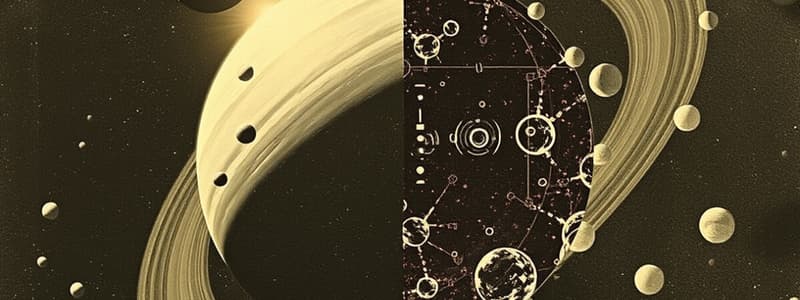Podcast
Questions and Answers
What is the primary function of Earth's magnetosphere?
What is the primary function of Earth's magnetosphere?
- To support the growth of vegetation
- To protect against solar wind and radiation (correct)
- To maintain the Earth's temperature
- To generate gravitational pull
Which aspect differentiates Earth and Mars regarding their habitability?
Which aspect differentiates Earth and Mars regarding their habitability?
- Presence of mountains
- Availability of natural resources
- Distance from the Sun
- Existence of a magnetic shield (correct)
What was a significant factor in the early development of both Earth and Mars?
What was a significant factor in the early development of both Earth and Mars?
- Cold temperatures
- Presence of liquid water
- Active tectonic plates
- Thick atmospheres (correct)
What consequence did Mars face as a result of losing its magnetosphere?
What consequence did Mars face as a result of losing its magnetosphere?
How might future advancements assist in the search for life beyond Earth?
How might future advancements assist in the search for life beyond Earth?
What role did asteroid impacts play in the evolution of Earth and Mars?
What role did asteroid impacts play in the evolution of Earth and Mars?
Which planet is characterized as dry and lifeless compared to Earth?
Which planet is characterized as dry and lifeless compared to Earth?
What essential feature is necessary to maintain liquid water on a planet's surface?
What essential feature is necessary to maintain liquid water on a planet's surface?
Flashcards are hidden until you start studying
Study Notes
Potential for Detecting Life on Exoplanets
- Future advancements may allow scientists to scan stars for Earth-like planets and identify signatures of life.
- Direct examination of light from distant planets could facilitate studies on their habitability.
Earth and Mars: Comparison of Habitability
- Earth and Mars both lie within the Sun's Goldilocks Zone, enabling the possibility of liquid water.
- Earth has vast liquid oceans, while Mars is characterized as dry and lifeless.
- The key difference in habitability between the two planets is the presence of a magnetic shield.
Importance of Magnetic Shield
- The Earth’s magnetosphere protects it from solar wind and deadly radiation that can strip away the atmosphere.
- An atmosphere is essential for maintaining liquid water; without it, water would vaporize even at suitable temperatures.
Historical Context of Planetary Evolution
- Earth and Mars both possessed magnetospheres roughly 4 billion years ago.
- Both planets started violent, with asteroid impacts transforming them into molten bodies before cooling.
- Initially, both planets developed thick atmospheres that allowed liquid water to exist for over 100 million years.
Mars' Loss of Magnetic Protection
- Mars lost its magnetosphere, leading to the loss of its atmosphere due to solar wind.
- This loss resulted in the evaporation of oceans and transformation into the barren landscape observed today.
Conclusion
- The study of magnetospheres and atmospheric conditions provides vital clues for identifying truly habitable exoplanets.
- Understanding the historical losses of planetary features can inform the search for life beyond Earth.
Potential for Detecting Life on Exoplanets
- Advancements in technology may enable the detection of Earth-like planets around stars.
- Scientists could analyze light signatures from distant planets to assess their potential for supporting life.
Earth and Mars: Comparison of Habitability
- Both planets reside in the Sun's Goldilocks Zone, making it possible for liquid water to exist.
- Earth is abundant in liquid oceans, whereas Mars is known to be arid and seemingly lifeless.
- A crucial factor differentiating their habitability is Earth's magnetic shield, which Mars lacks.
Importance of Magnetic Shield
- Earth’s magnetosphere acts as a barrier against solar wind and harmful radiation, protecting the atmosphere.
- The presence of an atmosphere is critical for sustaining liquid water; without it, even suitable temperatures would lead to vaporization.
Historical Context of Planetary Evolution
- Approximately 4 billion years ago, both Earth and Mars had magnetospheres.
- Early planetary history involved violent collisions with asteroids, resulting in molten surfaces that later cooled.
- Initially, both planets had thick atmospheres that allowed liquid water to persist for over 100 million years.
Mars' Loss of Magnetic Protection
- The absence of a magnetosphere on Mars resulted in atmospheric loss due to exposure to solar wind.
- This atmospheric depletion led to the evaporation of Martian oceans, contributing to the current desolate terrain.
Conclusion
- Investigating magnetospheres and atmospheric conditions is essential for identifying potentially habitable exoplanets.
- Understanding how planets like Mars lost critical features aids in the exploration for life beyond Earth.
Studying That Suits You
Use AI to generate personalized quizzes and flashcards to suit your learning preferences.





